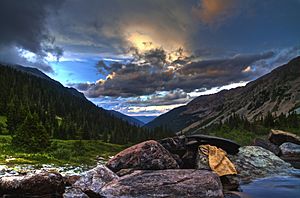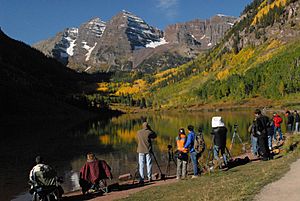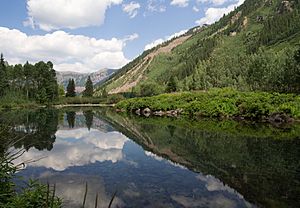Maroon Bells facts for kids
Quick facts for kids Maroon Bells |
|
|---|---|

Maroon Bells
|
|
| Highest point | |
| Peak | Maroon Peak |
| Elevation | 14,163 ft (4,317 m) NAVD88 |
| Prominence | 2336 ft (712 m) |
| Isolation | 8.06 mi (12.97 km) |
| Listing |
|
| Geography | |
| Location | Gunnison and Pitkin counties, Colorado, United States |
| Parent range | Elk Mountains |
| Topo map | USGS 7.5' topographic map Maroon Bells, Colorado |
| Climbing | |
| First ascent | 1890s by C. Wilson |
| Easiest route | Exposed scramble, class 4 |
The Maroon Bells are two amazing mountain peaks. They are called Maroon Peak and North Maroon Peak. These peaks are part of the Elk Mountains in Colorado, United States. They are about half a kilometer (one-third of a mile) apart.
The Maroon Bells are located on the border between Pitkin County and Gunnison County, Colorado. They are about 12 miles southwest of Aspen. Both peaks are known as fourteeners, which means they are over 14,000 feet tall. Maroon Peak is 14,163 feet (4,317 meters) high. North Maroon Peak is 14,014 feet (4,273 meters) high.
Many people love to photograph the Maroon Bells. The view from the Maroon Creek valley is especially famous. These beautiful peaks are found within the Maroon Bells–Snowmass Wilderness. This wilderness area is part of the White River National Forest. The Maroon Bells–Snowmass Wilderness was one of the first areas in Colorado to be protected as wilderness in 1964.
How the Maroon Bells Formed
The Maroon Bells mountains are made of a type of rock called mudstone. Mudstone is not very strong. It can break easily, which means the rocks on the mountains can be loose. This is why climbers need to be very careful.
The mudstone also gives the Maroon Bells their special maroon (reddish-brown) color. This unique color makes them stand out!
Maroon Lake is a beautiful lake near the mountains. It sits in a basin that was carved out by huge glaciers during the Ice Age. Later, landslides and falling rocks helped to create a natural dam, forming the lake we see today.
Fun Activities at Maroon Bells
The Maroon Bells area is a very popular place for visitors. Around 300,000 people come to see the Bells every year! Many people visit for just one day, while others stay overnight.
To help manage the large number of visitors, there is a bus service. It runs every day from mid-June through early October. During these times, most personal cars are not allowed. The bus takes visitors from Aspen Highlands to Maroon Lake. It runs about every 20 minutes.
The Maroon Bells area has many hiking trails. Some are short and easy, perfect for a quick walk near Maroon Lake. Others are longer and can be used for overnight backpacking trips into the Maroon-Snowmass Wilderness. It's a great place to explore nature!
Protecting the Maroon Bells
Because so many people visit the Maroon Bells, the U.S. Forest Service (USFS) has a plan to protect the area. This plan helps keep the scenic beauty and wilderness safe for everyone.
Some of the rules include:
- Backcountry campers must use special containers called bear canisters to store their food. This keeps bears safe and prevents them from getting human food.
- Visitors are asked to keep their dogs on leashes.
- There are rules about how many people can camp in certain spots.
- Some areas have limits on how long you can stay.
Recently, the USFS started a permit system for overnight stays. This system helps control the number of campers. It also helps protect the environment from too much use. You need a permit all year round to camp in the Conundrum Creek Valley area. Campsites have limits on how many people can stay, usually between 2 and 6.
Each person can get up to two permits per year. From June 1 to September 1, you can stay for a maximum of 3 nights. For the rest of the year, you can stay up to 7 nights. Places like the Conundrum Hot Springs are very popular, sometimes attracting up to 300 people a night!
Environmental Care at Maroon Bells
With so many visitors each year, the Maroon Bells area can experience some environmental challenges. It's important to understand these impacts to help protect this special place.
Keeping Water Clean
The Maroon Bells area is surrounded by Maroon Creek. This creek flows into Crater Lake and Maroon Lake. These lakes and streams are important sources of fresh water. They get their water from melting snow and rain. The city of Aspen, Colorado, also uses this water.
In 2003, officials were concerned about high levels of nitrogen in the water. More people and cars in Colorado can lead to more pollution in the air. When it rains or snows, these pollutants can fall into the lakes and rivers. Too much nitrogen can harm fish, insects, and plants that live in the water.
Protecting Trails from Wear
Another challenge from many visitors is trail erosion. This happens when trails get worn down from too much foot traffic. The Maroon Bells has many trails for day hikes and overnight trips. Popular trails around Maroon and Crater Lake are used a lot.
Sometimes, hikers create "social trails" by walking off the main paths. These unofficial trails can damage plants and the natural beauty of the area. In 2018, a project started to "rope off" sensitive areas. This helps keep people on the main trails and protects the fragile ecosystem.
Managing Human Waste
With more people on the trails and in wilderness areas, human waste has become a concern. Visitors sometimes do not dispose of waste properly. This can happen around Conundrum Hot Springs and other parts of the Maroon Bells Wilderness.
To help with this, the Forest Service started a human waste awareness campaign. They teach visitors how to dig "cat holes" to bury human waste properly. They also give out free portable toilets called "wag bags." Since the campaign began, there has been a decrease in improperly disposed human waste. This helps keep the wilderness clean and healthy for everyone.






